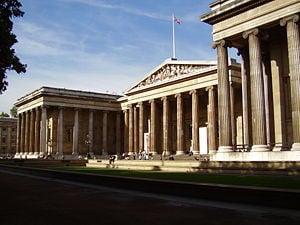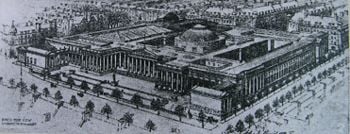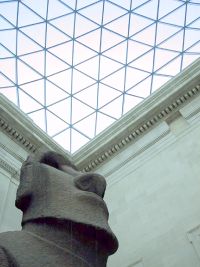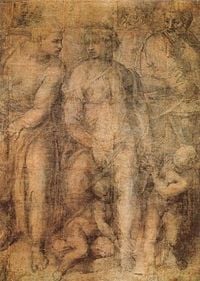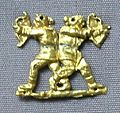British Museum
The British Museum in London, England, is one of the world's largest museums of human history and culture. Its collections, which number more than seven million objects from all continents, illustrate and document the story of human culture from its beginning to the present. As with all other national museums and art galleries in Britain, the museum charges no admission fee, although charges are levied for some temporary special exhibitions. The museum was established in 1753, based largely on the collections of the physician and scientist Sir Hans Sloane. It was first opened to the public on January 15, 1759, in Montagu House in Bloomsbury. Until 1997, when the British Library opened to the public, the British Museum was unique in that it housed both a national museum of antiquities and a national library in the same building. From its founding, the museum has endeavored to promote universal understanding through the arts, natural history, and science. Through its efforts, it has inspired and informed the public as well as contributing to the cultural and economic life of the area of London in which it is located.
History
The British Museum was founded in 1753, with the mission of holding in trust "a collection of art and antiquities from ancient and living cultures." The museum operates according to three guiding principles: "that the collections are held in perpetuity in their entirety, that they are widely available to all who seek to enjoy and learn from them, and that they are curated by full-time specialists."[1]
Though principally a museum of cultural art objects and antiquities, the British Museum was founded as a "universal museum." This is reflected in the first bequest by Sir Hans Sloane, comprising some 40,000 printed books, 7,000 manuscripts, extensive natural history specimens, prints by Albrecht Dürer, and antiquities from Egypt, Greece, Rome, the Middle East, the Far East, and the Americas. The Foundation Act, passed on June 7, 1753, added two other libraries to the Sloane collection. The Cottonian Library, assembled by Sir Robert Cotton, dated back to Elizabethan times, and the Harleian Library was the collection of the first and second Earls of Oxford. They were joined in 1757 by the Royal Library assembled by various British monarchs. Together these four "Foundation collections" included many of the most treasured books now in the British Library, including the Lindisfarne Gospels and the sole surviving copy of Beowulf.
The body of trustees (which until 1963 was chaired by the Archbishop of Canterbury, the Lord Chancellor, and the Speaker of the House of Commons) decided on Montagu House, which it bought from the Montagu family for £20,000, as the location for the museum. The trustees rejected Buckingham House, on a site now occupied by Buckingham Palace, on the grounds of cost and the unsuitability of its location.
After its foundation, the British Museum received several gifts, including the Thomason Library and David Garrick's library of 1,000 printed plays, but had few ancient relics and would have been unrecognizable to visitors of the modern museum. The first notable addition to the collection of antiquities was by Sir William Hamilton, British ambassador to Naples, who sold his collection of Greek and Roman artifacts to the museum in 1782. In the early nineteenth century, the foundations for the extensive collection of sculptures began to be laid. After the defeat of the French in the Battle of the Nile in 1801, the British Museum acquired more Egyptian sculptures and the Rosetta Stone. Many Greek sculptures followed, notably the Towneley collection in 1805 and the Elgin Marbles in 1816.
The collection soon outgrew its surroundings and the situation became urgent with the donation in 1822 of King George III's personal library of 65,000 volumes, 19,000 pamphlets, maps, charts, and topographical drawings to the museum. The old Montagu House was demolished in 1845 and replaced by a design by the neoclassical architect Sir Robert Smirke.
Roughly contemporary with the construction of the new building was the career of a man sometimes called the "second founder" of the British Museum, the Italian librarian Antonio Panizzi. Under his supervision the British Museum Library quintupled in size and became a well-organized institution worthy of being called a national library. The quadrangle at the center of Smirke's design proved to be a waste of valuable space and was filled at Panizzi's request by a circular Reading Room of cast iron, designed by Smirke's brother, Sydney Smirke. Despite being amongst the most famous rooms in the world, until December 2000, it was accessible only to those with a Reader's ticket. This is where notable scholars such as Virginia Woolf, Thomas Carlyle, and Karl Marx researched and wrote some of their most important works.
The natural history collections were an integral part of the British Museum until their removal to the new Natural History Museum in 1887. The ethnography collections were until recently housed in the short-lived Museum of Mankind in Piccadilly; they were returned to Bloomsbury and the department of ethnography was renamed the department of Africa, Oceania, and the Americas.
The temporary exhibition Treasures of Tutankhamun, held by the British Museum in 1972, was the most successful in British history, attracting 1,694,117 visitors. In the same year, the Act of Parliament establishing the British Library was passed, separating the collection of manuscripts and printed books from the British Museum. The government suggested a site at St. Pancras in London for the new British Library, but the books did not leave the museum until 1997.
With the book stacks in the central courtyard of the museum now empty, the process of demolition for Lord Foster's glass-roofed Great Court could begin. The Great Court, opened in 2000, while undoubtedly improving circulation around the museum, was criticized for having a lack of exhibition space at a time when the museum was in serious financial difficulties and many galleries were closed to the public. In 2002, the museum was even closed for a day when its staff protested about proposed redundancies. A few weeks later the theft of a small Greek statue was blamed on lack of security staff.
The Building
The current structure replaced Montagu House of 1686.
The Greek Revival façade facing Great Russell Street is a characteristic building of Sir Robert Smirke, with 44 Ionic columns, 13.7 meters high, closely based on those of the temple of Athena Polias at Priene in Asia Minor. The pediment over the main entrance is decorated by sculptures by Sir Richard Westmacott depicting The Progress of Civilization, consisting of fifteen allegorical figures, installed in 1852.
The construction commenced around the courtyard with the East Wing (the King's Library) from 1823 to 1828, followed by the North Wing in 1833 to 1838. Originally this housed, amongst other galleries, a reading room called the Welcome Gallery. Work also progressed on the northern half of the West Wing (the Egyptian Sculpture Gallery) from 1826 to 1831. Montagu House was demolished in 1842 to make room for the final part of the West Wing, which was completed in 1846, and the South Wing with its great colonnade. This was initiated in 1843, and completed in 1847, when the Front Hall and Great Staircase were opened to the public.
In 1846, Robert Smirke was replaced as the museum's architect by his brother Sydney Smirke, whose major addition was the Round Reading Room constructed from 1854 to 1857; at 42.6 meters in diameter, it was then the second-widest dome in the world, the Pantheon in Rome being slightly wider.
The next major addition was the White Wing, constructed from 1882 to 1884 behind the eastern end of the South Front, the architect being Sir John Taylor.
In 1895, the trustees purchased the 69 houses surrounding the museum with the intention of demolishing them and building around the west, north, and east sides of the museum new galleries that would completely fill the block on which the museum stands. Of this grand plan, only the Edward VII galleries in the center of the North Front were ever constructed. These were built from 1906 to 1914, to the design of Sir John James Burnet, and house the Asian and Islamic collections.
The Duveen Gallery, housing the Elgin Marbles, was designed by the American Beaux-Arts architect John Russell Pope. Although completed in 1938, it was hit by a bomb in 1940 and remained semi-derelict for 22 years before reopening in 1962.
The Queen Elizabeth II Great Court is a covered square at the center of the British Museum designed by Buro Happold and Foster and Partners. The Great Court opened in December 2000 and is the largest covered square in Europe. The roof is a glass and steel construction with 1,656 panes of uniquely shaped glass panes. At the centre of the Great Court is the Reading Room vacated by the British Library. The Reading Room is open to any member of the public who wishes to read there.
The Departments
The museum is divided into nine departments:
- Ancient Egypt and Sudan
Spanning 10,000 B.C.E. to the twelfth century C.E., these are probably the most comprehensive collections outside of their respective countries of origin.
- Asia
This department covers all of the continent's history plus the Islamic world to the present day. The collections covering Mesopotamia and the succeeding cultures are the finest outside Iraq.
- Coins and Medals
The numismatic collection consists of around 1,000,000 items. Its chronological scope is from the seventh century B.C.E. to the present day and its geographical scope is global.
- Africa, Oceania and the Americas
The collection mainly consists of nineteenth- and twentieth-century items, although the Inca, Aztec, Maya, and other early cultures are well represented; collecting of modern artifacts is ongoing.
- Greek and Roman Antiquities
The items in the collection cover c. 3200 B.C.E. to the fourth century C.E. and cover all geographical areas these cultures controlled or influenced.
- Prehistory and Europe
The prehistoric collections cover Europe, Africa, and Asia, the earliest African artifacts being dated as much as two million years old. Coverage of Europe extends to the present day.
- Prints and Drawings
This department covers Western graphic art from the fifteenth century to the present, containing around 50,000 drawings and 2,000,000 prints.
- Conservation, Documentation, and Science
This department was founded in 1924. Conservation has six specialist areas: ceramics and glass; metals; organic material (including textiles); stone, wall paintings and mosaics; Eastern pictorial art and Western pictorial art. The science department develops techniques to date artifacts, analyze and identify the materials used in their manufacture, and to identify the places artifacts originated and the techniques used in their creation. The department also publishes its findings and discoveries.
- Learning and Information
This department covers all levels of education, from casual visitors, schools, degree level and beyond. The museum's various libraries hold in excess of 350,000 books, journals, and pamphlets covering all areas of the museum's collection. The general museum archives, which date from its foundation in 1753, are overseen by this department; the individual departments have their own separate archives covering their various areas of responsibility.
The Collections
Highlights of the collections include:
- The Elgin Marbles, carvings from the Athenian Parthenon
- The Portland Vase
- The Rosetta Stone
- The Stein collection from Central Asia
- The Clock Room
- Works by Albrecht Dürer: more than 100 drawings and 900 prints
- Egyptian Mummies
- The Benin Bronzes
- The Cyrus Cylinder and many other Persian artifacts
- Anglo-Saxon artifacts from the Sutton Hoo burial
- The Lewis Chessmen
- The Mold cape (a Bronze Age gold ceremonial cape)
- The basalt moai (statue) Hoa Hakananai'a from Easter Island
- The Mildenhall Treasure
The notorious Cupboard 55 in the Department of Medieval and Later Antiquities, inaccessible by the public and known as "the Secretum," has a reputation for containing some of the most erotic objects in the British Museum. Though claiming to be from ancient cultures, many of the objects are Victorian fakes and are deemed unfit for public display on grounds of quality, rather than because of their supposed obscenity.
Controversy

It is a point of controversy whether museums should be allowed to possess artifacts taken from other countries, and the British Museum is a notable target for criticism. The Parthenon Marbles and the Benin Bronzes are among the most disputed objects in its collections, and organizations have been formed demanding the return of both sets of artifacts to their native countries of Greece and Nigeria respectively.
The British Museum has refused to return either set, or any of its other disputed items, stating that the "restitutionist premise, that whatever was made in a country must return to an original geographical site, would empty both the British Museum and the other great museums of the world."[2] The museum has also argued that the British Museum Act of 1963 legally prevents it from selling any of its valuable artifacts, even the ones not on display. Critics have particularly argued against the right of the British Museum to own objects that it does not share with the public.
Supporters of the museum claim that it has provided protection for artifacts that may have otherwise been damaged or destroyed if they had been left in their original environments. While some critics have accepted this, they also argue that the artifacts should now be returned to their countries of origin if there is sufficient expertise and desire there to preserve them. The British Museum continues to assert that it is an appropriate custodian:
The Acropolis Museum allows the Parthenon sculptures that are in Athens (approximately half of what survive from antiquity) to be appreciated against the backdrop of ancient Greek and Athenian history. The Parthenon sculptures in London, that represents 30% of the original scheme, are an important representation of ancient Athenian civilisation in the context of world history. Each year millions of visitors, free of charge, admire the artistry of the sculptures and gain insight into how ancient Greece influenced – and was influenced by – the other civilisations that it encountered. The Trustees are convinced that the current division allows different and complementary stories to be told about the surviving sculptures, highlighting their significance within world culture and affirming the place of Ancient Greece among the great cultures of the world.[3]
As a sign of dedication to legitimate ownership of artifacts, the museum even patrols the online auction site eBay for illicit artifacts of academic interest.[4]
In 2006, however, the museum did agree to return the bones of 17 Tasmanian Aborigines to Australia. The decision to do so was made out of consideration to a new law concerning the repatriation of artifacts.[5]
Controversial graffiti artist Banksy, whose identity remains unknown, but whose work is witty, subversive, and prolific,[6] raised interesting issues within the art world when he hung his own work on the wall of the museum, unbeknownst to curators. The work is a satirical piece made to look like a cave drawing on a piece of rock of a man with a shopping cart. The museum actually kept the piece on display after realizing it had been placed there.[7]
Galleries
Joseph E. Hotung Gallery (Asia)
Hellenistic galleries
Notes
- ↑ About Us. The British Museum. Retrieved December 10, 2006.
- ↑ 15th January 1759 - The British Museum opens This Day Then. Retrieved June 28, 2016.
- ↑ The Parthenon Sculptures: The position of the Trustees of the British Museum British Museum.
- ↑ Chris Williams, British Museum to police eBay, The Register, October 3, 2006. Retrieved November 29, 2006.
- ↑ Request for Repatriation of Human Remains to Tasmania British Museum.
- ↑ Banksy, Wall and Piece (Random House UK, 2005 ISBN 1844137864).
- ↑ Cave art hoax hits British Museum. BBC News. Retrieved November 29, 2006.
ReferencesISBN links support NWE through referral fees
- Banksy. Wall and Piece. Random House UK, 2005. ISBN 1844137864
- British Museum. The British Museum and its Collections. Published for the Trustees of the British Museum, 1982. ISBN 0714120170
- Caygill, Marjorie. Treasures of the British Museum. Harry N. Abrams, 1985. ISBN 0810916878
External links
All links retrieved November 21, 2023.
Credits
New World Encyclopedia writers and editors rewrote and completed the Wikipedia article in accordance with New World Encyclopedia standards. This article abides by terms of the Creative Commons CC-by-sa 3.0 License (CC-by-sa), which may be used and disseminated with proper attribution. Credit is due under the terms of this license that can reference both the New World Encyclopedia contributors and the selfless volunteer contributors of the Wikimedia Foundation. To cite this article click here for a list of acceptable citing formats.The history of earlier contributions by wikipedians is accessible to researchers here:
The history of this article since it was imported to New World Encyclopedia:
Note: Some restrictions may apply to use of individual images which are separately licensed.
